ENVIRONMENTAL ISSUES for Class 12 BIOLOGY
INTRODUCTION
- Pollution is any undesirable change in physical, chemical or biological characteristics of air, land, water or soil. Agents that bring about such an undesirable change are called pollutants. In order to control environmental pollution, the Government of India has passed the Environment (Protection) Act, 1986 to protect and improve the quality of our environment (air, water and soil).
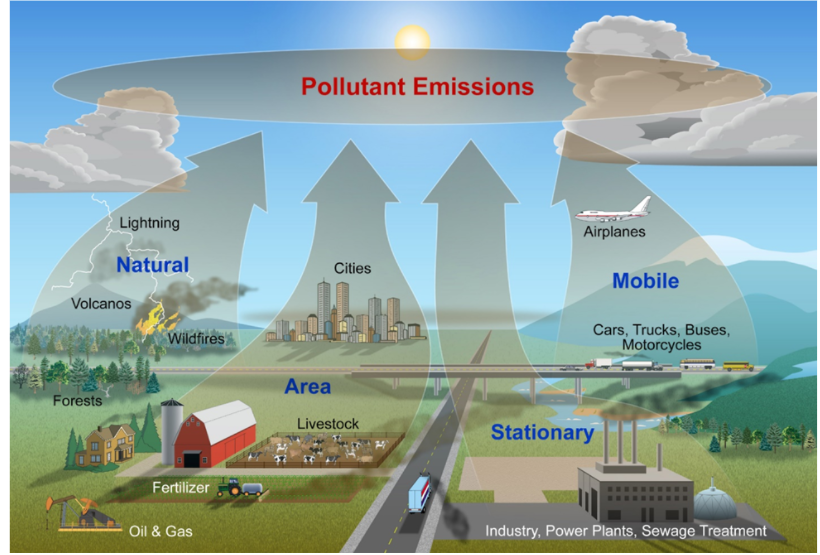
INTRODUCTION
- Pollution is any undesirable change in physical, chemical or biological characteristics of air, land, water or soil. Agents that bring about such an undesirable change are called pollutants. In order to control environmental pollution, the Government of India has passed the Environment (Protection) Act, 1986 to protect and improve the quality of our environment (air, water and soil).

CHAPTER WEIGHTAGE
- Beta ecology wali puri unit 14 marks ki hai jisme 4 chapters hai and yeah last chapter hai. Generally jo questions puche jate hai wo hai : precipitators, algal bloom, biomagnification, ozone depletion etc.
CHAPTER WEIGHTAGE
- Beta ecology wali puri unit 14 marks ki hai jisme 4 chapters hai and yeah last chapter hai. Generally jo questions puche jate hai wo hai : precipitators, algal bloom, biomagnification, ozone depletion etc.
Air Pollution and Its Control
- Wo koi bhi substance jo air ki quality ko degrade kare so much so ki usme breath karne wale organisms pe harmful effects dikhe uss substance ko hum air pollutant kehte hai and iss phenomenon ko air pollution kaha jata hai. Main culprits hai smoke and noise.
- Noise ko as a air pollutant kafi recently include kia gya hai kyunki higher levels ko noise like that of jet plane taking off or DJ affects the hearing capacity and may even lead to permanent hearing loss along with aggravation of other health conditions like stress, insomnia, hypertension and even heart disorders.
- Smoke ke sath deal karne ke liye factories are required to install filters in the chimneys taki chimney se nikalne wale smoke ko environment me release karne se pehle filter kia ja sake specially to remove soot particles jo ki bahut sari lung problems cause karte hai and existing conditions jaise ki asthma, allergy and chronic obstructive pulmonary disorders ko aggravate karte hai. Kuch patients jaise ki cystic fibrosis se pidit logo ke liye polluted air me breath karna unki life expectancy or bhi kam kar sakta hai plus it takes a toll on their bodies to deal with the sir pollution and lung function rapidly decline karna shuru karta hai.
- Automobiles me catalytic converters install kiye jate hai taki unburnt hydrocarbons yani ki soot particles are converted into carbon dioxide and water, and carbon monoxide and nitric oxide are changed to carbon dioxide and nitrogen gas, respectively.
- Electrostatic precipitators me ek electrode itne high voltage pe hota hai ki wo electrons ki corona produce karta hai and yeah electrons dust particles par chipak kar unhe negative charge dete hai and dusra electrode grounded hota hai toh these negatively dust particles ko attract karta hai.
- Scrubbers water ya lime water ko exhaust pe spray karke unse sulphur dioxide jaisi gases remove karte hai.
- Jo particulate matter sabse jyada harmful hai (<2.5 micrometer PM) unko electrostatic precipitators remove nahi kar pate toh unke liye hum catalytic converters use karte hai.
Air Pollution and Its Control
- Change and deterioration of the quality of the air which will negatively affect the health of organisms breathing in it can be defined as air pollution and the agents such as industrial smoke, cigarette smoke etc. which cause air pollution are known as air pollutants.
- Air pollutants cause injury to all living organisms. They reduce growth and yield of crops and cause premature death of plants. Air pollutants also deleteriously affect the respiratory system of humans and of animals. Harmful effects depend on the concentration of pollutants, duration of exposure and the organism.
- Control : Smokestacks of thermal power plants, smelters and other industries release particulate and gaseous air pollutants together with harmless gases, such as nitrogen, oxygen, etc. These pollutants must be separated/ filtered out before releasing the harmless gases into the atmosphere. There are several ways of removing particulate matter; the most widely used of which is the electrostatic precipitator, which can remove over 99 per cent particulate matter present in the exhaust from a thermal power plant. It has electrode wires that are maintained at several thousand volts, which produce a corona that releases electrons. These electrons attach to dust particles giving them a net negative charge. The collecting plates are grounded and attract the charged dust particles. The velocity of air between the plates must be low enough to allow the dust to fall.
→ A scrubber can remove gases like sulphur dioxide. In a scrubber, the exhaust is passed through a spray of water or lime. Recently we have realised the dangers of particulate matter that are very very small and are not removed by these precipitators.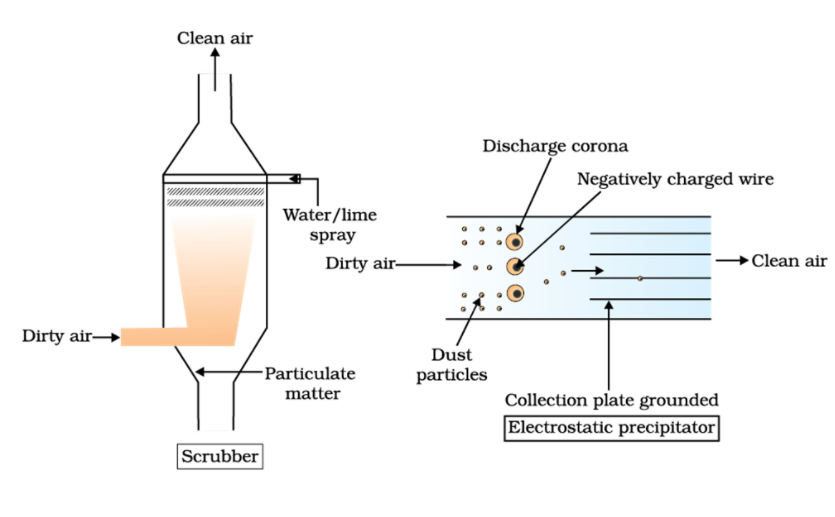
- According to Central Pollution Control Board (CPCB), particulate size 2.5 micrometers or less in diameter (PM 2.5) are responsible for causing the greatest harm to human health. These fine particulates can be inhaled deep into the lungs and can cause breathing and respiratory symptoms, irritation, inflammations and damage to the lungs and premature deaths.
- Catalytic converters, having expensive metals namely platinum-palladium and rhodium as the catalysts, are fitted into automobiles for reducing emission of poisonous gases. As the exhaust passes through the catalytic converter, unburnt hydrocarbons are converted into carbon dioxide and water, and carbon monoxide and nitric oxide are changed to carbon dioxide and nitrogen gas, respectively. Motor vehicles equipped with catalytic converter should use unleaded petrol because lead in the petrol inactivates the catalyst.
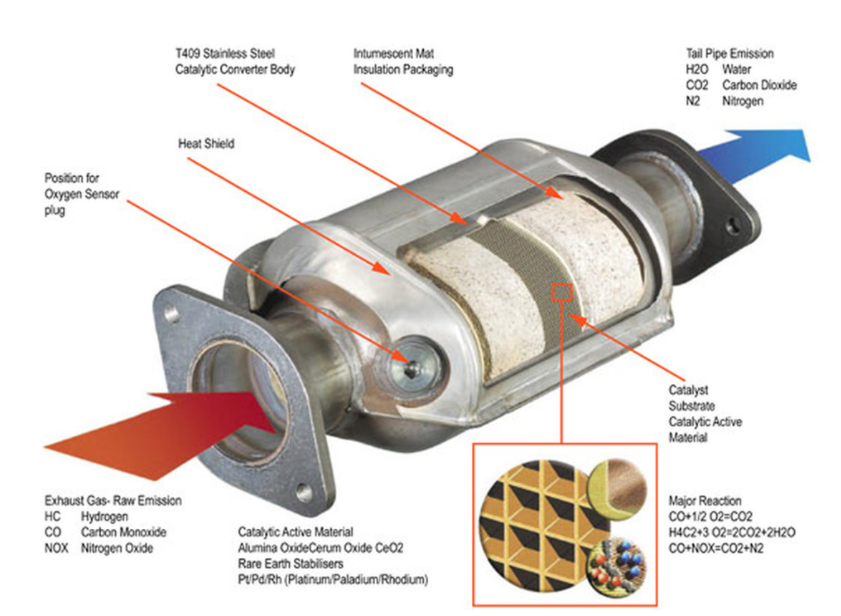
- In India, the Air (Prevention and Control of Pollution) Act came into force in 1981, but was amended in 1987 to include noise as an air pollutant. Noise is undesired high level of sound. Noise causes psychological and physiological disorders in humans. A brief exposure to extremely high sound level, 150 dB or more generated by take off of a jet plane or rocket, may damage ear drums thus permanently impairing hearing ability. Even chronic exposure to a relatively lower noise level of cities may permanently damage hearing abilities of humans. Noise also causes sleeplessness, increased heart beat, altered breathing pattern, thus considerably stressing humans.
- In the 1990s, Delhi ranked fourth among the 41 most polluted cities of the world. All the buses of Delhi were converted to run on CNG by the end of 2002.
- CNG burns most efficiently, unlike petrol or diesel, in the automobiles and very little of it is left unburnt. Moreover, CNG is cheaper than petrol or diesel, cannot be siphoned off by thieves and adulterated like petrol or diesel. The main problem with switching over to CNG is the difficulty of laying down pipelines to deliver CNG through distribution points/ pumps and ensuring uninterrupted supply.
- Step taken to reduce vehicular pollution : steps taken in Delhi for reducing vehicular pollution include phasing out of old vehicles, use of unleaded petrol, use of low-sulphur petrol and diesel, use of catalytic converters in vehicles, application of stringent pollution-level norms for vehicles, etc.
- Euro III norms, for example, stipulate that sulphur be controlled at 350 parts-per-million (ppm) in diesel and 150 ppm in petrol. Aromatic hydrocarbons are to be contained at 42 per cent of the concerned fuel. The goal, according to the roadmap, is to reduce sulphur to 50 ppm in petrol and diesel and bring down the level to 35 per cent. Corresponding to the fuel, vehicle engines will also need to be upgraded. Mass Emission Standards (Bharat Stage II which is equivalent to Euro- II norms) are no more applicable in any of the cities of India.
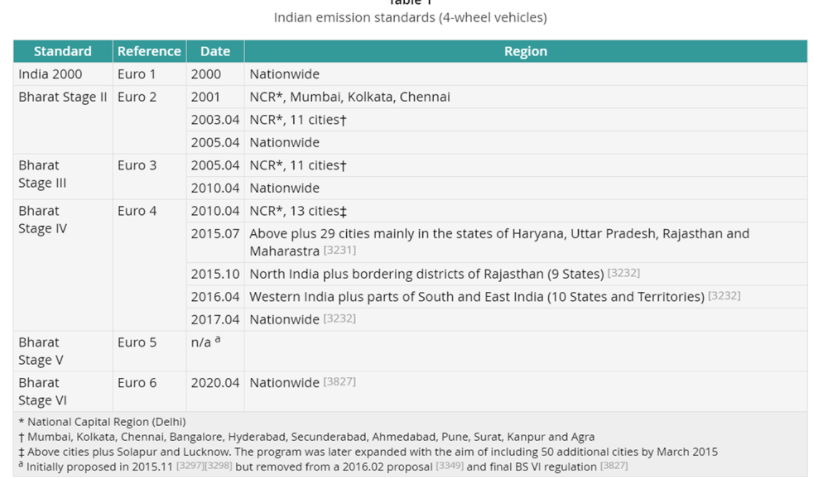
Delhi Case Study :
Air Pollution and Its Control
- Change and deterioration of the quality of the air which will negatively affect the health of organisms breathing in it can be defined as air pollution and the agents such as industrial smoke, cigarette smoke etc. which cause air pollution are known as air pollutants.
- Air pollutants cause injury to all living organisms. They reduce growth and yield of crops and cause premature death of plants. Air pollutants also deleteriously affect the respiratory system of humans and of animals. Harmful effects depend on the concentration of pollutants, duration of exposure and the organism.
- Control : Smokestacks of thermal power plants, smelters and other industries release particulate and gaseous air pollutants together with harmless gases, such as nitrogen, oxygen, etc. These pollutants must be separated/ filtered out before releasing the harmless gases into the atmosphere. There are several ways of removing particulate matter; the most widely used of which is the electrostatic precipitator, which can remove over 99 per cent particulate matter present in the exhaust from a thermal power plant. It has electrode wires that are maintained at several thousand volts, which produce a corona that releases electrons. These electrons attach to dust particles giving them a net negative charge. The collecting plates are grounded and attract the charged dust particles. The velocity of air between the plates must be low enough to allow the dust to fall.
→ A scrubber can remove gases like sulphur dioxide. In a scrubber, the exhaust is passed through a spray of water or lime. Recently we have realised the dangers of particulate matter that are very very small and are not removed by these precipitators.
- According to Central Pollution Control Board (CPCB), particulate size 2.5 micrometers or less in diameter (PM 2.5) are responsible for causing the greatest harm to human health. These fine particulates can be inhaled deep into the lungs and can cause breathing and respiratory symptoms, irritation, inflammations and damage to the lungs and premature deaths.
- Catalytic converters, having expensive metals namely platinum-palladium and rhodium as the catalysts, are fitted into automobiles for reducing emission of poisonous gases. As the exhaust passes through the catalytic converter, unburnt hydrocarbons are converted into carbon dioxide and water, and carbon monoxide and nitric oxide are changed to carbon dioxide and nitrogen gas, respectively. Motor vehicles equipped with catalytic converter should use unleaded petrol because lead in the petrol inactivates the catalyst.

- In India, the Air (Prevention and Control of Pollution) Act came into force in 1981, but was amended in 1987 to include noise as an air pollutant. Noise is undesired high level of sound. Noise causes psychological and physiological disorders in humans. A brief exposure to extremely high sound level, 150 dB or more generated by take off of a jet plane or rocket, may damage ear drums thus permanently impairing hearing ability. Even chronic exposure to a relatively lower noise level of cities may permanently damage hearing abilities of humans. Noise also causes sleeplessness, increased heart beat, altered breathing pattern, thus considerably stressing humans.
- In the 1990s, Delhi ranked fourth among the 41 most polluted cities of the world. All the buses of Delhi were converted to run on CNG by the end of 2002.
- CNG burns most efficiently, unlike petrol or diesel, in the automobiles and very little of it is left unburnt. Moreover, CNG is cheaper than petrol or diesel, cannot be siphoned off by thieves and adulterated like petrol or diesel. The main problem with switching over to CNG is the difficulty of laying down pipelines to deliver CNG through distribution points/ pumps and ensuring uninterrupted supply.
- Step taken to reduce vehicular pollution : steps taken in Delhi for reducing vehicular pollution include phasing out of old vehicles, use of unleaded petrol, use of low-sulphur petrol and diesel, use of catalytic converters in vehicles, application of stringent pollution-level norms for vehicles, etc.
- Euro III norms, for example, stipulate that sulphur be controlled at 350 parts-per-million (ppm) in diesel and 150 ppm in petrol. Aromatic hydrocarbons are to be contained at 42 per cent of the concerned fuel. The goal, according to the roadmap, is to reduce sulphur to 50 ppm in petrol and diesel and bring down the level to 35 per cent. Corresponding to the fuel, vehicle engines will also need to be upgraded. Mass Emission Standards (Bharat Stage II which is equivalent to Euro- II norms) are no more applicable in any of the cities of India.

Delhi Case Study :
Water Pollution & Its Control
- Government of India has passed the Water (Prevention and Control of Pollution) Act, 1974 to safeguard our water resources.
- A mere 0.1 per cent impurities make domestic sewage unfit for human Use.
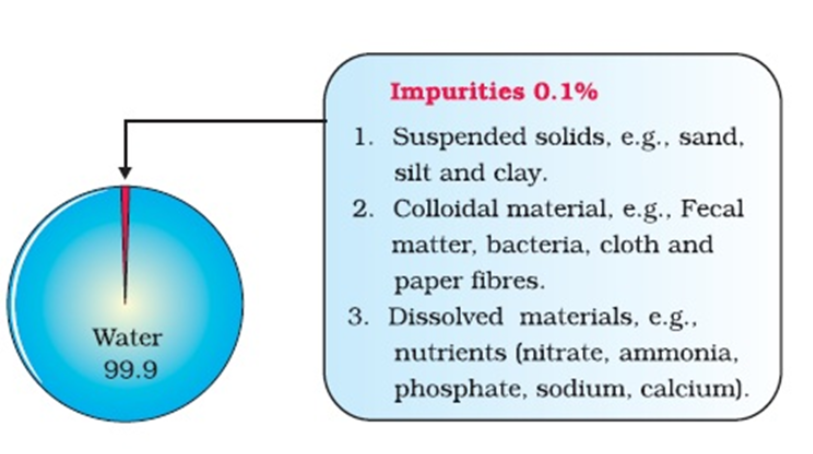
- Solids are relatively easy to remove, what is most difficult to remove are dissolved salts such as nitrates, phosphates, and other nutrients, and toxic metal ions and organic compounds. Domestic sewage primarily contains biodegradable organic matter, which readily decomposes – thanks to bacteria and other micro-organisms, which can multiply using these organic substances as substrates and hence utilise some of the components of sewage. It is possible to estimate the amount of biodegradable organic matter in sewage water by measuring Biochemical Oxygen Demand (BOD). Micro-organisms involved in biodegradation of organic matter in the receiving water body consume a lot of oxygen, and as a result there is a sharp decline in dissolved oxygen downstream from the point of sewage discharge. This causes mortality of fish and other aquatic creatures.
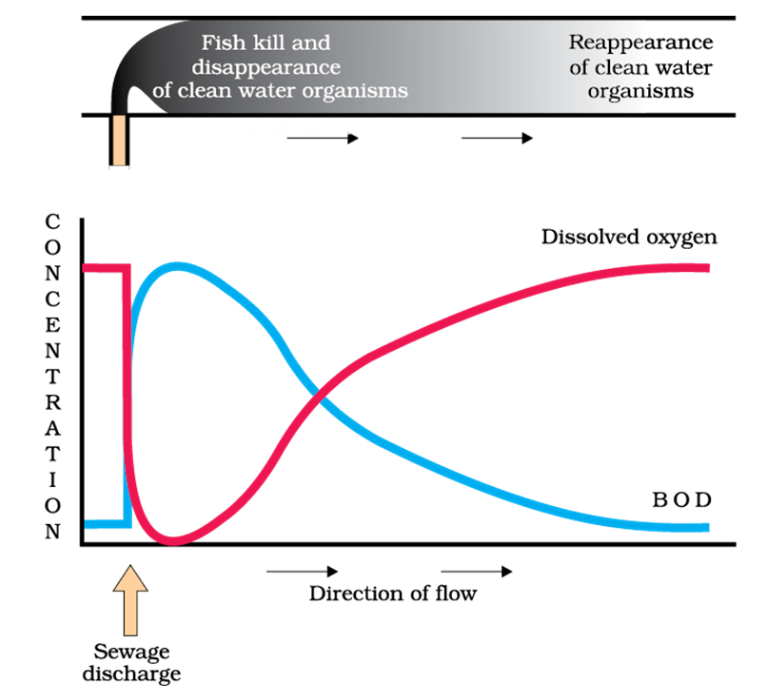
- Algal Bloom : Presence of large amounts of nutrients in waters also causes excessive growth of planktonic (free-floating) algae, called an algal bloom which imparts a distinct colour to the water bodies. Algal blooms cause deterioration of the water quality and fish mortality. Some bloom-forming algae are extremely toxic to human beings and animals. Water hyacinth (Eichhornia crassipes), the world’s most problematic aquatic weed, called ‘ Terror of Bengal’. They grow abundantly in eutrophic water bodies, and lead to an imbalance in the ecosystem dynamics of the water body.
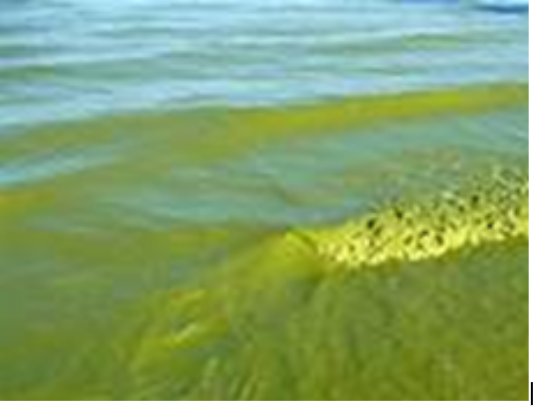
- Sewage from our homes as well as from hospitals are likely to contain many undesirable pathogenic microorganisms, and its disposal into a water without proper treatment may cause outbreak of serious diseases, such as, dysentery, typhoid, jaundice, cholera, etc. Unlike domestic sewage, waste water from industries like petroleum, paper manufacturing, metal extraction and processing, chemical manufacturing, etc., often contain toxic substances, notably, heavy metals (defined as elements with density > 5 g/cm3 such as mercury, cadmium, copper, lead, etc.) and a variety of organic Compounds.
- A few toxic substances, often present in industrial waste waters, can undergo biological magnification (Biomagnification) in the aquatic food chain. Biomagnification refers to increase in concentration of the toxicant at successive trophic levels. This happens because a toxic substance accumulated by an organism cannot be metabolised or excreted, and is thus passed on to the next higher trophic level. This phenomenon is well known for mercury and DDT. Figure given below shows biomagnification of DDT in an aquatic food chain. In this manner, the concentration of DDT is increased at successive trophic levels; say if it starts at 0.003 ppb (ppb = parts per billion) in water, it can ultimately reach 25 ppm (ppm = parts per million) in fish-eating birds, through biomagnification. High concentrations of DDT disturb calcium metabolism in birds, which causes thinning of eggshell and their premature breaking, eventually causing decline in bird populations.
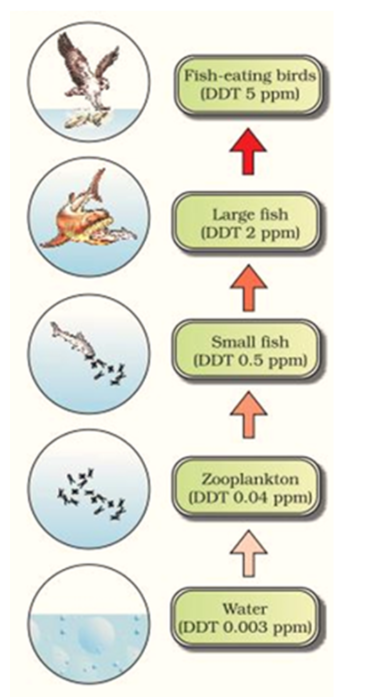
- Eutrophication is the natural aging of a lake by nutrient enrichment of its water. In a young lake the water is cold and clear, supporting little life. With time, streams draining into the lake introduce nutrients such as nitrogen and phosphorus, which encourage the growth of aquatic organisms. As the lake’s fertility increases, plant and animal life burgeons, and organic remains begin to be deposited on the lake bottom. Over the centuries, as silt and organic debris pile up, the lake grows shallower and warmer, with warm-water organisms supplanting those that thrive in a cold environment. Marsh plants take root in the shallows and begin to fill in the original lake basin. Eventually, the lake gives way to large masses of floating plants (bog), finally converting into land. Depending on climate, size of the lake and other factors, the natural aging of a lake may span thousands of years. However, pollutants from man’s activities like effluents from the industries and homes can radically accelerate the aging process. This phenomenon has been called Cultural or Accelerated Eutrophication The prime contaminants are nitrates and phosphates, which act as plant nutrients. They overstimulate the growth of algae, causing unsightly scum and unpleasant odors, and robbing the water of dissolved oxygen vital to other aquatic life. At the same time, other pollutants flowing into a lake may poison whole populations of fish, whose decomposing remains further deplete the water’s dissolved oxygen content. In such fashion, a lake can literally choke to death.
- Wastewater including sewage can be treated in an integrated manner, by utilising a mix of artificial and natural processes. An example of such an initiative is the town of Arcata, situated along the northern coast of California.
- The cleaning occurs in two stages – (a) the conventional sedimentation, filtering and chlorine treatments are given. After this stage, lots of dangerous pollutants like dissolved heavy metals still remain. To combat this, an innovative approach was taken and (b) the biologists developed a series of six connected marshes over 60 hectares of marshland. Appropriate plants, algae, fungi and bacteria were seeded into this area, which neutralise, absorb and assimilate the pollutants. Hence, as the water flows through the marshes, it gets purified naturally.
- A citizens group called Friends of the Arcata Marsh (FOAM) are responsible for the upkeep and safeguarding of this wonderful project. Human excreta can be recycled into a resource (as natural fertiliser), which reduces the need for chemical fertilisers. There are working ‘EcoSan’ toilets in many areas of Kerala and Sri Lanka.
Integrated Waste Water Treatment
Water Pollution
- Drinking water me agar 0.1% bhi impurities hai toh wo human consumption ke liye safe nahi hai. Aur hum solids waste ko toh fir bhi aasani se remove kar sakte hai lekin dissolved chemicals and heavy metals ions uske sath sath pathogens ko remove karna thoda sa tricky hai.
- Polluted water me Biochemical oxygen demand baht hi high hoti hai kyunki microorganisms uss water me organic waste ko break kar hote hai jiske liye unhe oxygen chahiyeah ab jitna jyada pani me organic waste hoga utni hi uski BOD high hogi and yeah sab hum chapter 10 me bhi sewage water treatment me padh chuke hai detail me.
- Jab pani me nutrients ki amount jyada hoti hai toh uske karan uss pani me algae ki growth jyada ho jati hai and hume water body ke surface pe ek greenish blackish sheet dikhti hai jo ki actual me alage and issi ko hum algal bloom kehte hai. Main disadvantage yeah hai ki algae ki overgrowth ki karan baki water living organisms ke liye dissolved oxygen ki amount kam hojati hai and wo marna shur kar dete hai jiske karan ultimately wo water body pollute ho jati hai.
- Jo hum pesticides ya baki agro-chemical use karte hai wo bhi ultimately water bodies ko pollute karte hai leads to biomagnification yani ki kisi bhi pollutant ki amount jaise jaise hum higher trophic level ki taraf jate hai toh uss pollutant ki concentration badhti jati hai jaise ki maanlo water me jo plants hai unme DDT chemical ki concentration 1ppm hai toh zooplankton me yeah amount badh kar for example 5 ppm ho gyi then zooplankton ko khane wali small fishes me aur jyada concentration hogi DDT ki and yhi phenomenon biomagnification kehlata hai.
- Eutrophication ka matlab hai lake ki accelerated growth jisme ki algal bloom jaise phenomenon included hai and yeah tab hota hai water body me nitrates and phosphates jaise nutrients ki amount badh jati hai.
SOLID WASTES
- Solid wastes refer to everything that goes out in trash. Municipal solid wastes are wastes from homes, offices, stores, schools, hospitals, etc., that are collected and disposed by the municipality. The municipal solid wastes generally comprise paper, food wastes, plastics, glass, metals, rubber, leather, textile, etc.
- Sanitary landfills were adopted as the substitute for open-burning dumps. In a sanitary landfill, wastes are dumped in a depression or trench after compaction, and covered with dirt everyday. Landfills are also not really much of a solution since the amount of garbage generation specially in the metros has increased so much that these sites are getting filled too. Also there is danger of seepage of chemicals, etc., from these landfills polluting the underground water resources.
- All waste that we generate can be categorised into three types – (a) biodegradable, (b) recyclable and (c) the non-biodegradable. The biodegradable materials can be put into deep pits in the ground and be left for natural breakdown. That leaves only the nonbiodegradable to be disposed off . The need to reduce our garbage generation should be a prime goal, instead, we are increasing the use of non-biodegradable products.State Governments across the country are trying to push for reduction in use of plastics and use of eco-friendly packaging.
- Hospitals generate hazardous wastes that contain disinfectants and other harmful chemicals, and also pathogenic microorganisms. Such wastes also require careful treatment and disposal. The use of incinerators is crucial to disposal of hospital waste. Irreparable computers and other electronic goods are known as electronic wastes (e-wastes). E-wastes are buried in landfills or incinerated. Over half of the e-wastes generated in the developed world are exported to developing countries, mainly to China, India and Pakistan, where metals like copper, iron, silicon, nickel and gold are recovered during recycling process. Recycling is the only solution for the treatment of e-waste, provided it is carried out in an environment friendly Manner.
- Polyblend, a fine powder of recycled modified plastic is mixed with the bitumen that is used to lay roads. In collaboration with R.V.College of Engineering and the Bangalore City Corporation, Ahmed Khan proved that blends of Polyblend and bitumen, when used to lay roads, enhanced the bitumen’s water repellant properties, and helped to increase road life by a factor of three. The raw material for creating Polyblend is any plastic film waste.
- So, against the price of Rs. 0.40 per kg that rag pickers had been getting for plastic waste, Khan now offers Rs.6. Using Khan’s technique, by the year 2002, more than 40 kms of road in Bangalore has already been laid. At this rate, Khan will soon be running short of plastic waste in Bangalore, to produce Polyblend. Thanks to innovations like Polyblend, we might still avoid being smothered by plastic waste.
Water Pollution & Its Control
- Government of India has passed the Water (Prevention and Control of Pollution) Act, 1974 to safeguard our water resources.
- A mere 0.1 per cent impurities make domestic sewage unfit for human Use.

- Solids are relatively easy to remove, what is most difficult to remove are dissolved salts such as nitrates, phosphates, and other nutrients, and toxic metal ions and organic compounds. Domestic sewage primarily contains biodegradable organic matter, which readily decomposes – thanks to bacteria and other micro-organisms, which can multiply using these organic substances as substrates and hence utilise some of the components of sewage. It is possible to estimate the amount of biodegradable organic matter in sewage water by measuring Biochemical Oxygen Demand (BOD). Micro-organisms involved in biodegradation of organic matter in the receiving water body consume a lot of oxygen, and as a result there is a sharp decline in dissolved oxygen downstream from the point of sewage discharge. This causes mortality of fish and other aquatic creatures.

- Algal Bloom : Presence of large amounts of nutrients in waters also causes excessive growth of planktonic (free-floating) algae, called an algal bloom which imparts a distinct colour to the water bodies. Algal blooms cause deterioration of the water quality and fish mortality. Some bloom-forming algae are extremely toxic to human beings and animals. Water hyacinth (Eichhornia crassipes), the world’s most problematic aquatic weed, called ‘ Terror of Bengal’. They grow abundantly in eutrophic water bodies, and lead to an imbalance in the ecosystem dynamics of the water body.

- Sewage from our homes as well as from hospitals are likely to contain many undesirable pathogenic microorganisms, and its disposal into a water without proper treatment may cause outbreak of serious diseases, such as, dysentery, typhoid, jaundice, cholera, etc. Unlike domestic sewage, waste water from industries like petroleum, paper manufacturing, metal extraction and processing, chemical manufacturing, etc., often contain toxic substances, notably, heavy metals (defined as elements with density > 5 g/cm3 such as mercury, cadmium, copper, lead, etc.) and a variety of organic Compounds.
- A few toxic substances, often present in industrial waste waters, can undergo biological magnification (Biomagnification) in the aquatic food chain. Biomagnification refers to increase in concentration of the toxicant at successive trophic levels. This happens because a toxic substance accumulated by an organism cannot be metabolised or excreted, and is thus passed on to the next higher trophic level. This phenomenon is well known for mercury and DDT. Figure given below shows biomagnification of DDT in an aquatic food chain. In this manner, the concentration of DDT is increased at successive trophic levels; say if it starts at 0.003 ppb (ppb = parts per billion) in water, it can ultimately reach 25 ppm (ppm = parts per million) in fish-eating birds, through biomagnification. High concentrations of DDT disturb calcium metabolism in birds, which causes thinning of eggshell and their premature breaking, eventually causing decline in bird populations.

- Eutrophication is the natural aging of a lake by nutrient enrichment of its water. In a young lake the water is cold and clear, supporting little life. With time, streams draining into the lake introduce nutrients such as nitrogen and phosphorus, which encourage the growth of aquatic organisms. As the lake’s fertility increases, plant and animal life burgeons, and organic remains begin to be deposited on the lake bottom. Over the centuries, as silt and organic debris pile up, the lake grows shallower and warmer, with warm-water organisms supplanting those that thrive in a cold environment. Marsh plants take root in the shallows and begin to fill in the original lake basin. Eventually, the lake gives way to large masses of floating plants (bog), finally converting into land. Depending on climate, size of the lake and other factors, the natural aging of a lake may span thousands of years. However, pollutants from man’s activities like effluents from the industries and homes can radically accelerate the aging process. This phenomenon has been called Cultural or Accelerated Eutrophication The prime contaminants are nitrates and phosphates, which act as plant nutrients. They overstimulate the growth of algae, causing unsightly scum and unpleasant odors, and robbing the water of dissolved oxygen vital to other aquatic life. At the same time, other pollutants flowing into a lake may poison whole populations of fish, whose decomposing remains further deplete the water’s dissolved oxygen content. In such fashion, a lake can literally choke to death.
- Wastewater including sewage can be treated in an integrated manner, by utilising a mix of artificial and natural processes. An example of such an initiative is the town of Arcata, situated along the northern coast of California.
- The cleaning occurs in two stages – (a) the conventional sedimentation, filtering and chlorine treatments are given. After this stage, lots of dangerous pollutants like dissolved heavy metals still remain. To combat this, an innovative approach was taken and (b) the biologists developed a series of six connected marshes over 60 hectares of marshland. Appropriate plants, algae, fungi and bacteria were seeded into this area, which neutralise, absorb and assimilate the pollutants. Hence, as the water flows through the marshes, it gets purified naturally.
- A citizens group called Friends of the Arcata Marsh (FOAM) are responsible for the upkeep and safeguarding of this wonderful project. Human excreta can be recycled into a resource (as natural fertiliser), which reduces the need for chemical fertilisers. There are working ‘EcoSan’ toilets in many areas of Kerala and Sri Lanka.
Integrated Waste Water Treatment
Agro-Chemical & Their Effects
- Pesticides, herbicides, fungicides, etc.,are also toxic to non-target organisms,that are important components of the soil ecosystem. Addition of increasing amounts of chemical fertilisers can do to aquatic ecosystems vis-à-vis eutrophication.
- Case Study : Integrated organic farming is a cyclical, zero-waste procedure, where waste products from one process are cycled in as nutrients for other processes. This allows the maximum utilisation of resource and increases the efficiency of production. Ramesh Chandra Dagar, a farmer in Sonipat, Haryana, is doing just this. He includes bee-keeping, dairy management, water harvesting, composting and agriculture in a chain of processes, which support each other and allow an extremely economical and sustainable venture. There is no need to use chemical fertilisers for crops, as cattle excreta (dung) are used as manure. Crop waste is used to create compost, which can be used as a natural fertiliser or can be used to generate natural gas for satisfying the energy needs of the farm. Enthusiastic about spreading information and help on the practice of integrated organic farming, Dagar has created the Haryana Kisan Welfare Club, with a current membership of 5000 farmers.
SOLID WASTES
- Bhar kudey me jani wali jitni bhi solid cheezein hai jaise ki office ya kitchen waste ya hospital waste wo sab solid wastes ki category me aate hai and depending upon the source ki yeah particular waste khan se aaya hai unko hum biodegradable, non biodegradable ya recyclable ki category me segregate karke particular measures se unko dump karte hai jaise ki office waste me jo ki mainly paper waste hote hai wo easily recyclable hai. Plastic wastes are non biodegradable and inka environment me direct disposal bahut hi harmful hai toh hum closed containers jnko incinerators kehte hai unme inko jla dete hai taki inki burning se nikalne wale fumes jo ki toxic hote hai wo directly environment me na jaye and hum unko kuch level pe filter karke hi environment me release karte hai so that at least unki toxicity minimise ho sake. Biodegradable kitchen waste ko pits me bhar ke decomposition ke liye chor dete hai. Human excreta and cattle dung etc. can be used as manures in green farming. Plastic se related neeche ek case story di gayi hai, do make sure to read that one too.
Radioactive Wastes
- Use of nuclear energy has two very serious inherent problems. The first is accidental leakage, as occurred in the Three Mile Island and Chernobyl incidents and the second is safe disposal of radioactive wastes. Radiation, that is given off by nuclear waste is extremely damaging to organisms, because it causes mutations at a very high rate. At high doses, nuclear radiation is lethal but at lower doses, it creates various disorders, the most frequent of all being cancer. Therefore, nuclear waste is an extremely potent pollutant and has to be dealt with utmost caution. It has been recommended that storage of nuclear waste, after sufficient pre-treatment, should be done in suitably shielded containers buried within the rocks, about 500 m deep below the earth’s surface.
SOLID WASTES
- Solid wastes refer to everything that goes out in trash. Municipal solid wastes are wastes from homes, offices, stores, schools, hospitals, etc., that are collected and disposed by the municipality. The municipal solid wastes generally comprise paper, food wastes, plastics, glass, metals, rubber, leather, textile, etc.
- Sanitary landfills were adopted as the substitute for open-burning dumps. In a sanitary landfill, wastes are dumped in a depression or trench after compaction, and covered with dirt everyday. Landfills are also not really much of a solution since the amount of garbage generation specially in the metros has increased so much that these sites are getting filled too. Also there is danger of seepage of chemicals, etc., from these landfills polluting the underground water resources.
- All waste that we generate can be categorised into three types – (a) biodegradable, (b) recyclable and (c) the non-biodegradable. The biodegradable materials can be put into deep pits in the ground and be left for natural breakdown. That leaves only the nonbiodegradable to be disposed off . The need to reduce our garbage generation should be a prime goal, instead, we are increasing the use of non-biodegradable products.State Governments across the country are trying to push for reduction in use of plastics and use of eco-friendly packaging.
- Hospitals generate hazardous wastes that contain disinfectants and other harmful chemicals, and also pathogenic microorganisms. Such wastes also require careful treatment and disposal. The use of incinerators is crucial to disposal of hospital waste. Irreparable computers and other electronic goods are known as electronic wastes (e-wastes). E-wastes are buried in landfills or incinerated. Over half of the e-wastes generated in the developed world are exported to developing countries, mainly to China, India and Pakistan, where metals like copper, iron, silicon, nickel and gold are recovered during recycling process. Recycling is the only solution for the treatment of e-waste, provided it is carried out in an environment friendly Manner.
- Polyblend, a fine powder of recycled modified plastic is mixed with the bitumen that is used to lay roads. In collaboration with R.V.College of Engineering and the Bangalore City Corporation, Ahmed Khan proved that blends of Polyblend and bitumen, when used to lay roads, enhanced the bitumen’s water repellant properties, and helped to increase road life by a factor of three. The raw material for creating Polyblend is any plastic film waste.
- So, against the price of Rs. 0.40 per kg that rag pickers had been getting for plastic waste, Khan now offers Rs.6. Using Khan’s technique, by the year 2002, more than 40 kms of road in Bangalore has already been laid. At this rate, Khan will soon be running short of plastic waste in Bangalore, to produce Polyblend. Thanks to innovations like Polyblend, we might still avoid being smothered by plastic waste.
Greenhouse Effect and Global Warming
- The greenhouse effect is a naturally occurring phenomenon that is responsible for heating of Earth’s surface and atmosphere. Without greenhouse effect the average temperature at surface of Earth would have been a chilly –18oC rather than the present average of 15oC.
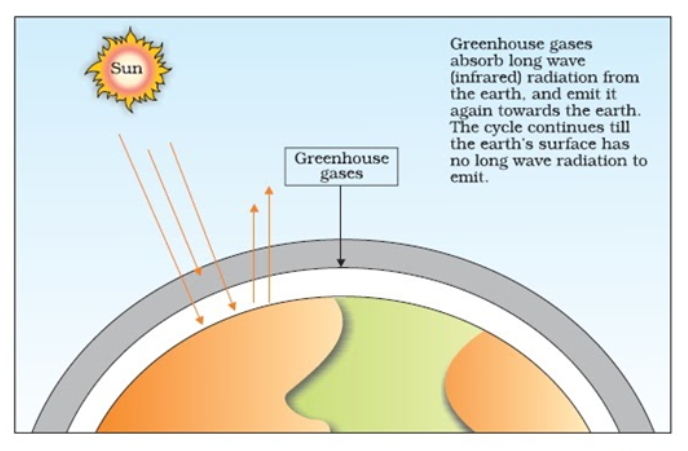
- Clouds and gases reflect about one-fourth of the incoming solar radiation, and absorb some of it but almost half of incoming solar radiation falls on Earth’s surface heating it, while a small proportion is reflected back. Earth’s surface re-emits heat in the form of infrared radiation but part of this does not escape into space as atmospheric gases (e.g., carbon dioxide, methane, etc.) absorb a major fraction of it. The molecules of these gases radiate heat energy, and a major part of which again comes to Earth’s surface, thus heating it up once again. This cycle is repeated many a times. The above-mentioned gases – carbon dioxide and methane – are commonly known as greenhouse gases because they are responsible for the greenhouse effect.
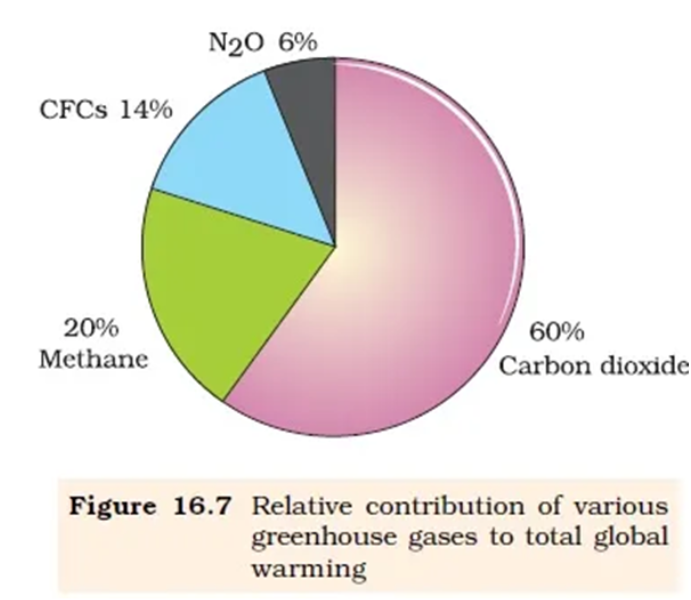
- Increase in the level of greenhouse gases has led to considerable heating of Earth leading to global warming. During the past century, the temperature of Earth has increased by 0.6oC, most of it during the last three decades. Scientists believe that this rise in temperature is leading to deleterious changes in the environment and resulting in odd climatic changes (e.g. El Nino effect) , thus leading to increased melting of polar ice caps as well as of other places like the Himalayan snow caps. Over many years, this will result in a rise in sea level that can submerge many coastal areas.
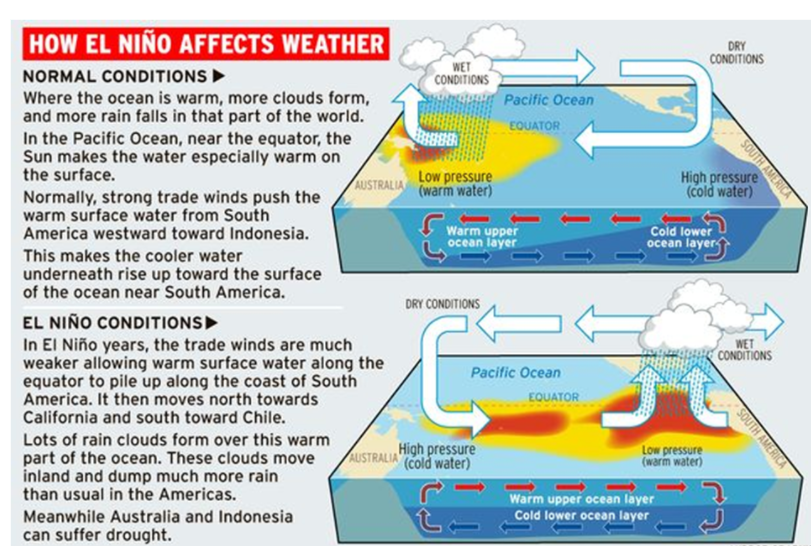
Agro-Chemical & Their Effects
- Agriculture me bhi hum aaj kal yield badhane ke liye and different diseases se fight karne ke liye bahut sare chemical ko agriculture practices me use karte hai jaise ki insecticides, pesticides, chemical fertilizers, herbicides and fungicides vgarah jo ki nature me eutrophication and biomagnification ke through accumulate hokar apne toxic effects show karte hai. Aajkal hum almost sabhi vegetables and fruit ko grow karne ke liye in agro chemicals ka use karte hai jinme kuch irritant ya gastrointestinal problems crete karte hai jabki kuch chemicals jaise ki organophosphate and unme honi wali poisoning toh even lethal bhi hai humans ke liye toh inhi karno ki vajah se hume organic farming ki taraf shift hona pda so that hum natural agents ko use karke maximum to maximum benefits le sake and minimum ya no chemical use se food grow kar sake. Integrated organic farming me farming ko baki processes jaise ki pisciculture ya beekeeping ke sath integrate kar lete hai jise ki sabhi processes ek dusre ko positively support kare, chemical needs ko kam karke jitna possible ho utna kam waste produce kare and environment ko kam se kam nuksaan pahuchaye.
Ozone Depletion & Stratosphere
- ‘Bad’ ozone, formed in the lower atmosphere (troposphere) that harms plants and animals. There is ‘good’ ozone also; this ozone is found in the upper part of the atmosphere called the stratosphere, and it acts as a shield absorbing ultraviolet radiation from the sun. UV rays are highly injurious to living organisms since DNA and proteins of living organisms preferentially absorb UV rays, and its high energy breaks the chemical bonds within these molecules. The thickness of the ozone in a column of air from the ground to the top of the atmosphere is measured in terms of Dobson units (DU). Ozone gas is continuously formed by the action of UV rays on molecular oxygen, and also degraded into molecular oxygen in the stratosphere. There should be a balance between production and degradation of ozone in the stratosphere. Of late, the balance has been disrupted due to enhancement of ozone degradation by chlorofluorocarbons (CFCs). CFCs find wide use as refrigerants. CFCs discharged in the lower part of atmosphere move upward and reach stratosphere. In stratosphere, UV rays act on them releasing Cl atoms. Cl degrades ozone releasing molecular oxygen, with these atoms acting merely as catalysts; Cl atoms are not consumed in the reaction. Hence, whatever CFCs are added to the stratosphere, they have permanent and continuing affects on Ozone levels. Although ozone depletion is occurring widely in the stratosphere, the depletion is particularly marked over the Antarctic region. This has resulted in formation of a large area of thinned ozone layer, commonly called as the ozone hole.
- UV radiation of wavelengths shorter than UV-B, are almost completely absorbed by Earth’s atmosphere, given that the ozone layer is intact. But, UV-B damages DNA and mutation may occur. It causes aging of skin, damage to skin cells and various types of skin cancers. In human eye, cornea absorbs UV-B radiation, and a high dose of UV-B causes inflammation of cornea, called snow-blindness, cataract, etc. Such exposure may permanently damage the cornea. an international treaty, known as the Montreal Protocol, was signed at Montreal (Canada) in 1987 (effective in 1989) to control the emission of ozone depleting substances. Subsequently many more efforts have been made and protocols have laid down definite roadmaps, separately for developed and developing countries, for reducing the emission of CFCs and other ozone depleting chemicals.
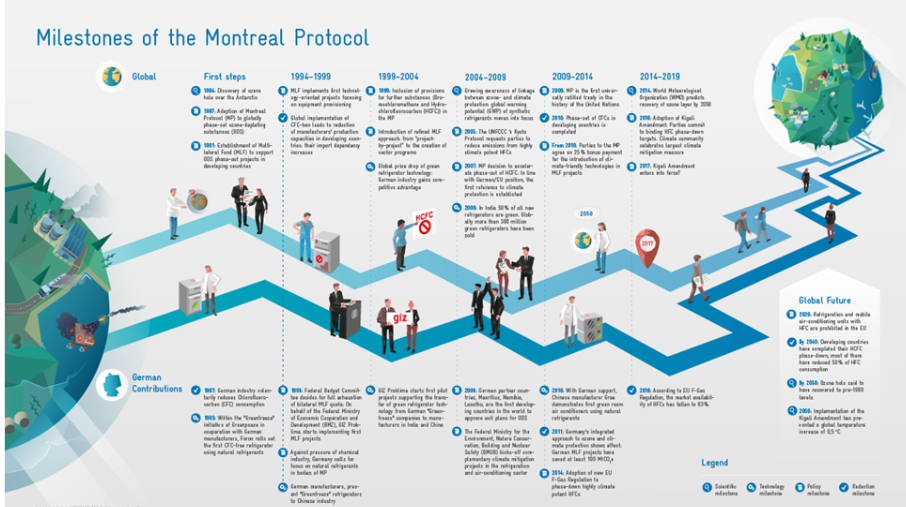
Agro-Chemical & Their Effects
- Pesticides, herbicides, fungicides, etc.,are also toxic to non-target organisms,that are important components of the soil ecosystem. Addition of increasing amounts of chemical fertilisers can do to aquatic ecosystems vis-à-vis eutrophication.
- Case Study : Integrated organic farming is a cyclical, zero-waste procedure, where waste products from one process are cycled in as nutrients for other processes. This allows the maximum utilisation of resource and increases the efficiency of production. Ramesh Chandra Dagar, a farmer in Sonipat, Haryana, is doing just this. He includes bee-keeping, dairy management, water harvesting, composting and agriculture in a chain of processes, which support each other and allow an extremely economical and sustainable venture. There is no need to use chemical fertilisers for crops, as cattle excreta (dung) are used as manure. Crop waste is used to create compost, which can be used as a natural fertiliser or can be used to generate natural gas for satisfying the energy needs of the farm. Enthusiastic about spreading information and help on the practice of integrated organic farming, Dagar has created the Haryana Kisan Welfare Club, with a current membership of 5000 farmers.
Degradation By Improper Resource Utilisation & Maintenance
- The degradation of natural resources can occur, not just by the action of pollutants but also by improper resource utilisation practices. Soil erosion and desertification: The development of the fertile top-soil takes centuries. But, it can be removed very easily due to human activities like over-cultivation, unrestricted grazing, deforestation and poor irrigation practices, resulting in arid patches of land. When large barren patches extend and meet over time, a desert is created. Internationally, it has been recognised that desertification is a major problem nowadays, particularly due to increased urbanisation. Waterlogging and soil salinity: Irrigation without proper drainage of water leads to waterlogging in the soil. Besides affecting the crops, waterlogging draws salt to the surface of the soil. The salt then is deposited as a thin crust on the land surface or starts collecting at the roots of the plants. This increased salt content is inimical to the growth of crops and is extremely damaging to agriculture. Waterlogging and soil salinity are some of the problems that have come in the wake of the Green Revolution.
Radioactive Wastes
- Starting me hum sochte thy ki nuclear energy koi waste generate nai karti lekin yeah sach nahi hai. Radioactive substances ka accidental leakage and unka propal disposal bahut bada issue hai kyunki yeah radiation living organisms ke liye harmful hai as they cause mutations toh proper disposal yani ki radioactive waste ko ache se pehle chemical ke sath treat karke then unko ache se thick shielded containers me daal unko rocks me 500mtr neeche bury karna hota hai taki wo living beings ke contact me aakr radioactive poisoning na kare but yeah method bhi kafi debatable hai and morally and ethically bhi ek greyish area me hai toh until we have any further regulation yeah hi standard method hai radioactive wastes ko dispose off karne ka.
Deforestation
- Deforestation is the conversion of forested areas to non-forested ones. According to an estimate, almost 40 per cent forests have been lost in the tropics, compared to only 1 per cent in the temperate region. At th beginning of the twentieth century, forests covered about 30 per cent of the land of India. By the end of the century, it shrunk to 19.4 per cent, whereas the National Forest Policy (1988) of India has recommended 33 per cent forest cover for the plains and 67 per cent for the hills.
- Slash and burn agriculture, commonly called as Jhum cultivation in the north-eastern states of India, has also contributed to deforestation. In slash and burn agriculture, the farmers cut down the trees of the forest and burn the plant remains. The ash is used as a fertiliser and the land is then used for farming or cattle grazing. After cultivation, the area is left for several years so as to allow its recovery. The farmers then move on to other areas and repeat this process. In earlier days, when Jhum cultivation was in prevalence, enough time-gap was given such that the land recovered from the effect of cultivation. With increasing population, and repeated cultivation, this recovery phase is done away with, resulting in deforestation.
- One of the major effects is enhanced carbon dioxide concentration in the atmosphere because trees that could hold a lot of carbon in their biomass are lost with deforestation. Deforestation also causes loss of biodiversity due to habitat destruction, disturbs hydrologic cycle, causes soil erosion, and may lead to desertification in extreme cases.
- Reforestation is the process of restoring a forest that once existed but was removed at some point of time in the past. Reforestation may occur naturally in a deforested area. However, we can speed it up by planting trees with due consideration to biodiversity that earlier existed in that area.
- Case Study : In 1731, the king of Jodhpur in Rajasthan asked one of his ministers to arrange wood for constructing a new palace. The minister and workers went to a forest near a village, inhabited by Bishnois, to cut down trees. The Bishnoi community is known for its peaceful co-existence with nature. The effort to cut down trees by the kings was thwarted by the Bishnois. A Bishnoi woman Amrita Devi showed exemplary courage by hugging a tree and daring king’s men to cut her first before cutting the tree. The tree mattered much more to her than her own life. Sadly, the king’s men did not heed to her pleas, and cut down the tree along with Amrita Devi. Her three daughters and hundreds of other Bishnois followed her, and thus lost their lives saving trees. Nowhere in history do we find a commitment of this magnitude when human beings sacrificed their lives for the cause of the environment. The Government of India has recently instituted the Amrita Devi Bishnoi Wildlife Protection Award for individuals or communities from rural areas that have shown extraordinary courage and dedication in protecting wildlife.
- Chipko Movement of Garhwal Himalayas : In 1974, local women showed enormous bravery in protecting trees from the axe of contractors by hugging them. People all over the world have acclaimed the Chipko movement.
- Realising the significance of participation by local communities, the Government of India in 1980s has introduced the concept of Joint Forest Management (JFM) so as to work closely with the local communities for protecting and managing forests. In return for their services to the forest, the communities get benefit of various forest products (e.g., fruits, gum, rubber, medicine, etc.), and thus the forest can be conserved in a sustainable manner.
Radioactive Wastes
- Use of nuclear energy has two very serious inherent problems. The first is accidental leakage, as occurred in the Three Mile Island and Chernobyl incidents and the second is safe disposal of radioactive wastes. Radiation, that is given off by nuclear waste is extremely damaging to organisms, because it causes mutations at a very high rate. At high doses, nuclear radiation is lethal but at lower doses, it creates various disorders, the most frequent of all being cancer. Therefore, nuclear waste is an extremely potent pollutant and has to be dealt with utmost caution. It has been recommended that storage of nuclear waste, after sufficient pre-treatment, should be done in suitably shielded containers buried within the rocks, about 500 m deep below the earth’s surface.
Summary
- Major issues relating to environmental pollution and depletion of valuable natural resources vary in dimension from local, regional to global levels. Air pollution primarily results from burning of fossil fuel, e.g., coal and petroleum, in industries and in automobiles. They are harmful to humans, animals and plants, and therefore must be removed to keep our air clean. Domestic sewage, the most common source of pollution of water bodies, reduces dissolved oxygen but increases biochemical oxygen demand of receiving water. Domestic sewage is rich in nutrients, especially, nitrogen and phosphorus, which cause eutrophication and nuisance algal blooms. Industrial waste waters are often rich in toxic chemicals, especially heavy metals and organic compounds. Industrial waste waters harm living organisms. Municipal solid wastes also create problems and must be disposed off in landfills. Disposal of hazardous wastes like defunct ships, radioactive wastes and e-wastes requires additional efforts. Soil pollution primarily results from agricultural chemicals (e.g., pesticides) and leachates from solid wastes deposited over it.
- Two major environmental issues of global nature are increasing greenhouse effect, which is warming Earth, and depletion of ozone in the stratosphere. Enhanced greenhouse effect is mainly due to increased emission of carbon dioxide, methane, nitrous oxide and CFCs., and also due to deforestation. It may drastically change rainfall pattern, global temperature, besides deleteriously affecting living organisms. Ozone in the stratosphere, which protects us from harmful effects of ultraviolet radiation, is depleting fast due to emission of CFCs thus increasing the risks of skin cancer, mutation and other disorders.
Greenhouse Effect and Global Warming
- Greenhouse effect ek naturally occurring phenomenon hai jo ki earth surface ki heating ke liye responsible hai. Sun radiation me jo infrared rays hoti hai kuch gases jinko hum greenhouse gases kehte hai un IR radiation ko absorb karke earth ki taraf wapis release kar dete hai, even earth surface bhi jo radiation re-emit karta hai wo bhi yeah gases absorb karke wapis re emit karti hai.
- In greenhouse gases ki increased amount se earth ka total temperature badhne ;agta hai jo ki specially polar areas and glaciers ke liye harmful as it leads to melting of glaciers jo ki fir sea level me pani ki amount increase karte hai and then aas paas ki vegetation and earth surface pani me doob jati hai jo ki vhan ki flora and fauna dono ke liye harmful hai thus eventually greenhouse effect ek limit se jyada hone pe negative effects show karta hai and inko counteract karne ke liye hum greenhouse gases jaise ki carbon dioxide and methane ke emission ko rona hoga jiska ek main tareeka hai jyada se jyda plants lgana yani ki afforestation and fossil fuel jaise ki coal, petrol, diesel ki jagah CNG ka use karna ya electric vehicle karna and using public transport instead ko personal vehicles might seem small steps but plays a major role.
Greenhouse Effect and Global Warming
- The greenhouse effect is a naturally occurring phenomenon that is responsible for heating of Earth’s surface and atmosphere. Without greenhouse effect the average temperature at surface of Earth would have been a chilly –18oC rather than the present average of 15oC.

- Clouds and gases reflect about one-fourth of the incoming solar radiation, and absorb some of it but almost half of incoming solar radiation falls on Earth’s surface heating it, while a small proportion is reflected back. Earth’s surface re-emits heat in the form of infrared radiation but part of this does not escape into space as atmospheric gases (e.g., carbon dioxide, methane, etc.) absorb a major fraction of it. The molecules of these gases radiate heat energy, and a major part of which again comes to Earth’s surface, thus heating it up once again. This cycle is repeated many a times. The above-mentioned gases – carbon dioxide and methane – are commonly known as greenhouse gases because they are responsible for the greenhouse effect.

- Increase in the level of greenhouse gases has led to considerable heating of Earth leading to global warming. During the past century, the temperature of Earth has increased by 0.6oC, most of it during the last three decades. Scientists believe that this rise in temperature is leading to deleterious changes in the environment and resulting in odd climatic changes (e.g. El Nino effect) , thus leading to increased melting of polar ice caps as well as of other places like the Himalayan snow caps. Over many years, this will result in a rise in sea level that can submerge many coastal areas.

Ozone Depletion & Stratosphere
- Ozone lower atmosphere me living organisms ke liye toxic hoti hai lekin iske uper ke zone me yani kis stratosphere me good ozone bhi hai jo sunlight me se UV rays ko filter karke hi earth me bhejti hai and yeah itna jaruri isiliye hai kyunki UV sabhi living organisms ke liye harmful hai kyunki yeah cancer, burns, irritation, se lekr genetic mutations tak cause kar sakti hai. Generally nature me apne aap, ozone ki formation and degradation me ek balance hota hai lekin aajkal wo balance lost ho chuka because of some anthropological activities jisme se chlorofluorocarbon/ CFCs ke karan hone wala ozone degradation ek bahut hi major pollutant hai. CFCs ozone me permanently rehte hai yani ke yeah khud degrade nhi hote lekin ozone ko degrade karte rehte hai jiske karan us area me ozone ki thickness bahut hi kam reh jati hai and ussi ko hum ozone hole kehte hai. Ozone layer Uv-B rays ko completely absorb kar leti hai jo ki DNA ko sabse jyada harm pahuchati hai lekin agar ozone intact nahi hai jo ki aaj kal nahi hi hai toh UV-B rays se eye ki problems, mutations ka rate and cancer ka khatra bahut hi jyada hai toh we have to develop ways to protect ourselves so we invented Sunscreens. Yeah aisi creams hai ebta jinme aise chemicals ya metal oxides jaise ki zinc oxides vgarah hoti hai jo sunlight ko reflect karti hai taki humari skin cells usko absorb na kare and uske harmful effects se hum protected rahe. Ozone depleting substances ke emission ke rok tham ke liye 1989 se montreal treaty ko lagu kiya gya jo ki 1987 me Canada me sign ki gyi thi.
Ozone Depletion & Stratosphere
- ‘Bad’ ozone, formed in the lower atmosphere (troposphere) that harms plants and animals. There is ‘good’ ozone also; this ozone is found in the upper part of the atmosphere called the stratosphere, and it acts as a shield absorbing ultraviolet radiation from the sun. UV rays are highly injurious to living organisms since DNA and proteins of living organisms preferentially absorb UV rays, and its high energy breaks the chemical bonds within these molecules. The thickness of the ozone in a column of air from the ground to the top of the atmosphere is measured in terms of Dobson units (DU). Ozone gas is continuously formed by the action of UV rays on molecular oxygen, and also degraded into molecular oxygen in the stratosphere. There should be a balance between production and degradation of ozone in the stratosphere. Of late, the balance has been disrupted due to enhancement of ozone degradation by chlorofluorocarbons (CFCs). CFCs find wide use as refrigerants. CFCs discharged in the lower part of atmosphere move upward and reach stratosphere. In stratosphere, UV rays act on them releasing Cl atoms. Cl degrades ozone releasing molecular oxygen, with these atoms acting merely as catalysts; Cl atoms are not consumed in the reaction. Hence, whatever CFCs are added to the stratosphere, they have permanent and continuing affects on Ozone levels. Although ozone depletion is occurring widely in the stratosphere, the depletion is particularly marked over the Antarctic region. This has resulted in formation of a large area of thinned ozone layer, commonly called as the ozone hole.
- UV radiation of wavelengths shorter than UV-B, are almost completely absorbed by Earth’s atmosphere, given that the ozone layer is intact. But, UV-B damages DNA and mutation may occur. It causes aging of skin, damage to skin cells and various types of skin cancers. In human eye, cornea absorbs UV-B radiation, and a high dose of UV-B causes inflammation of cornea, called snow-blindness, cataract, etc. Such exposure may permanently damage the cornea. an international treaty, known as the Montreal Protocol, was signed at Montreal (Canada) in 1987 (effective in 1989) to control the emission of ozone depleting substances. Subsequently many more efforts have been made and protocols have laid down definite roadmaps, separately for developed and developing countries, for reducing the emission of CFCs and other ozone depleting chemicals.

Degradation By Improper Resource Utilisation & Maintenance
- Natural resources ka improper way me carelessly use karna bhi unko degrade karna shuru kar deta hai.
- Human practices jaise ki over-cultivation, unrestricted grazing, deforestation and poor irrigation practices se soil badi jaldi degrade karna shuru kar deti hai jabki fertile soil ki development ke liye bahut sari centuries tak lag jati hai toh we have to careful and maintain a equilibrium while using natural resources.
- Irrigation bina kisi drainage facility ke liye bhi harmful kyunki fir uss land area me pani khada rehta hai and soil ko waterlogg kar deta hai jiske karan agar vhan koi crop hai usko breathing ke liye air nahi mil pati. Waterlogging ke karan soil se salts soil ke surface par accumulate hokr soil ki salinity ko bhi increase ar dete hai jo ki again soil ko cultivation and baki plant species ke liye unfit kar deti hai.
Degradation By Improper Resource Utilisation & Maintenance
- The degradation of natural resources can occur, not just by the action of pollutants but also by improper resource utilisation practices. Soil erosion and desertification: The development of the fertile top-soil takes centuries. But, it can be removed very easily due to human activities like over-cultivation, unrestricted grazing, deforestation and poor irrigation practices, resulting in arid patches of land. When large barren patches extend and meet over time, a desert is created. Internationally, it has been recognised that desertification is a major problem nowadays, particularly due to increased urbanisation. Waterlogging and soil salinity: Irrigation without proper drainage of water leads to waterlogging in the soil. Besides affecting the crops, waterlogging draws salt to the surface of the soil. The salt then is deposited as a thin crust on the land surface or starts collecting at the roots of the plants. This increased salt content is inimical to the growth of crops and is extremely damaging to agriculture. Waterlogging and soil salinity are some of the problems that have come in the wake of the Green Revolution.
Deforestation
- Deforestation ka matlab hai trees ko katna and forest ko kisi or cheez me establish karna jaise ki forests ko kat kar pehle raja maharaja apne mahal banwa lete thy ya aaj kal hum log factories establish karte hai toh total numbers of plants and forests, yeah decrease ho jate ai jo ki environment me balance ko bigad deta hai.
- 20th century tak forests ka area 30% se ghat kar keval 19.4% hi reh gya tha and 1988 me National Forest Policy banaiee gyi thi.
- Slum and burn agriculture ya fir jhum culture aisi practice hai jisme crop harvesting ke baad crops ki roots se uper ka hissa jo field me bacha hota hai ya baki waste ko jla kar uss ash ko ussi mitti me milakr kuch years ke liye chor dete hai taki bache hue plant parts ki ash me jo minerals thy wo soil me jakr soil ki fertility ko next crop ke liye badha de lekin ek major nuksaan iss practice ka yeah hai ki burning of plant parts leads to pollution. Fir farmers kisi new location par jakr vhan ke forest me jitne tress hai unko kaat kar jla denge and uss ash ko as a fertiliser use karnege apni crop ke liye. Then farmers move to another land and pehle wali land ko cultivation se recover karne ke liye acha khasa samay diya jata tha 5-10 yrs lekin badhti population ke sath yeah recovery phase kam hota ja rha hai which is leading to repeated deforestation.
- 1731 me jab Jodhpur ke Maharaja ne ek forest ko kaat kar apna mahal banwane ke liye apne workers ko bheja toh uss forest ke paas Bishnoi community ka ek gaon tha and unke liye wo forest kaafi maayne rakhta tha toh jab workers trees cut kanre aaye toh uss gaon ki Amrita Devi ne workers ko bola ki agar unhe paid katne hai toh pehle un workers ko Amrita Ji ko marna hoga nad wo apne paas ke ek tree se chipak gyi. Unfortunately workers ne uss Amrita Ji ko maar dala and uss tree ko bhi cut karna shuru kar diya. Yeah dekh kar Amrita ji ki teeno betiyon and gaon ke baki inhabitants ne yeahi kiya and uss protest me kafi sare Bishnoi Community ke logo ne apni kurbani di to save that forest and finally Maharaja ne wo project drop kar dia. Similar events hue thy 1974 me Garhwal ki chipko movement me.<
- Fir 1980s me government ne Joint Forest Management (JFM) movement shuru ki.
Deforestation
- Deforestation is the conversion of forested areas to non-forested ones. According to an estimate, almost 40 per cent forests have been lost in the tropics, compared to only 1 per cent in the temperate region. At th beginning of the twentieth century, forests covered about 30 per cent of the land of India. By the end of the century, it shrunk to 19.4 per cent, whereas the National Forest Policy (1988) of India has recommended 33 per cent forest cover for the plains and 67 per cent for the hills.
- Slash and burn agriculture, commonly called as Jhum cultivation in the north-eastern states of India, has also contributed to deforestation. In slash and burn agriculture, the farmers cut down the trees of the forest and burn the plant remains. The ash is used as a fertiliser and the land is then used for farming or cattle grazing. After cultivation, the area is left for several years so as to allow its recovery. The farmers then move on to other areas and repeat this process. In earlier days, when Jhum cultivation was in prevalence, enough time-gap was given such that the land recovered from the effect of cultivation. With increasing population, and repeated cultivation, this recovery phase is done away with, resulting in deforestation.
- One of the major effects is enhanced carbon dioxide concentration in the atmosphere because trees that could hold a lot of carbon in their biomass are lost with deforestation. Deforestation also causes loss of biodiversity due to habitat destruction, disturbs hydrologic cycle, causes soil erosion, and may lead to desertification in extreme cases.
- Reforestation is the process of restoring a forest that once existed but was removed at some point of time in the past. Reforestation may occur naturally in a deforested area. However, we can speed it up by planting trees with due consideration to biodiversity that earlier existed in that area.
- Case Study : In 1731, the king of Jodhpur in Rajasthan asked one of his ministers to arrange wood for constructing a new palace. The minister and workers went to a forest near a village, inhabited by Bishnois, to cut down trees. The Bishnoi community is known for its peaceful co-existence with nature. The effort to cut down trees by the kings was thwarted by the Bishnois. A Bishnoi woman Amrita Devi showed exemplary courage by hugging a tree and daring king’s men to cut her first before cutting the tree. The tree mattered much more to her than her own life. Sadly, the king’s men did not heed to her pleas, and cut down the tree along with Amrita Devi. Her three daughters and hundreds of other Bishnois followed her, and thus lost their lives saving trees. Nowhere in history do we find a commitment of this magnitude when human beings sacrificed their lives for the cause of the environment. The Government of India has recently instituted the Amrita Devi Bishnoi Wildlife Protection Award for individuals or communities from rural areas that have shown extraordinary courage and dedication in protecting wildlife.
- Chipko Movement of Garhwal Himalayas : In 1974, local women showed enormous bravery in protecting trees from the axe of contractors by hugging them. People all over the world have acclaimed the Chipko movement.
- Realising the significance of participation by local communities, the Government of India in 1980s has introduced the concept of Joint Forest Management (JFM) so as to work closely with the local communities for protecting and managing forests. In return for their services to the forest, the communities get benefit of various forest products (e.g., fruits, gum, rubber, medicine, etc.), and thus the forest can be conserved in a sustainable manner.
Summary
- Major issues relating to environmental pollution and depletion of valuable natural resources vary in dimension from local, regional to global levels. Air pollution primarily results from burning of fossil fuel, e.g., coal and petroleum, in industries and in automobiles. They are harmful to humans, animals and plants, and therefore must be removed to keep our air clean. Domestic sewage, the most common source of pollution of water bodies, reduces dissolved oxygen but increases biochemical oxygen demand of receiving water. Domestic sewage is rich in nutrients, especially, nitrogen and phosphorus, which cause eutrophication and nuisance algal blooms. Industrial waste waters are often rich in toxic chemicals, especially heavy metals and organic compounds. Industrial waste waters harm living organisms. Municipal solid wastes also create problems and must be disposed off in landfills. Disposal of hazardous wastes like defunct ships, radioactive wastes and e-wastes requires additional efforts. Soil pollution primarily results from agricultural chemicals (e.g., pesticides) and leachates from solid wastes deposited over it.
- Two major environmental issues of global nature are increasing greenhouse effect, which is warming Earth, and depletion of ozone in the stratosphere. Enhanced greenhouse effect is mainly due to increased emission of carbon dioxide, methane, nitrous oxide and CFCs., and also due to deforestation. It may drastically change rainfall pattern, global temperature, besides deleteriously affecting living organisms. Ozone in the stratosphere, which protects us from harmful effects of ultraviolet radiation, is depleting fast due to emission of CFCs thus increasing the risks of skin cancer, mutation and other disorders.
